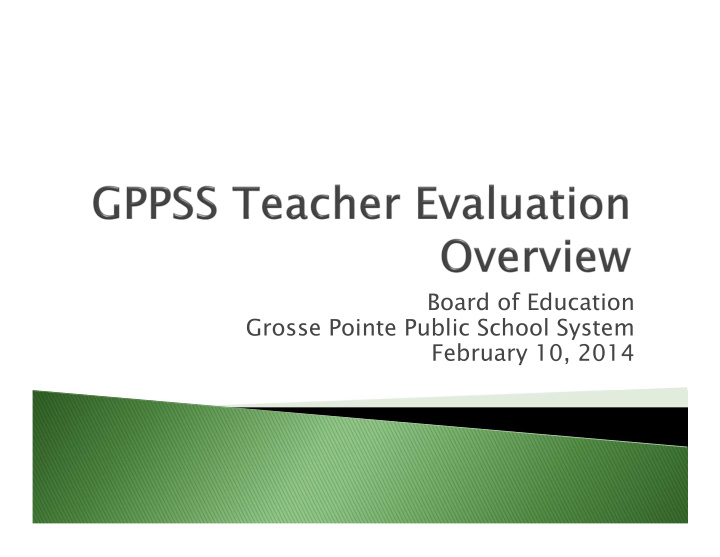



Board of Education Grosse Pointe Public School System February 10, 2014
Various current legal mandates regarding teacher evaluation GPPSS teacher evaluation rubric GPPSS teacher evaluation process review Potential changes to the teacher evaluation process
Fair Transparent Rigorous Identical Between Buildings
Annual evaluation for all teachers Multiple observations for all teachers Evaluations will inform employment decisions 4 Rating Categories: ◦ Highly Effective ◦ Effective ◦ Minimally Effective ◦ Ineffective
July 2011 Mandated Changes Included: Various requirements regarding mentoring and Individualized Development Plans The formation of a state level committee (MCEE) to further direct teacher evaluation actions in Michigan A focus on student growth: ◦ 2013-14 – 25% of overall evaluation ◦ 2014-15 – 40% of overall evaluation ◦ 2015-16 – 50% of overall evaluation
Based on the various law changes the district administration formed a ‘work group’ that has met regularly this year to: Ensure compliance with the law Develop and update necessary processes and forms Create professional development for teachers and administrators regarding teacher evaluation
The district uses the rubrics from Charlotte Danielson’s: Enhancing Professional Practice: A Framework for Teaching This rubric has been used by some administrators and teachers in GPPSS since the 2011-12 school year
Specific rubrics for: Teachers Therapeutic Specialists Counselors Psychologists Social Workers Library Media Specialists
Four domains within each rubric: 1. Planning and Preparation 2. The Classroom Environment 3. Instruction 4. Professional Responsibilities
Domain 2: Instruction: 2a) Creating an Environment of Respect and Rapport 2b) Establishing a Culture for Learning 2c) Managing Classroom Procedures 2d) Managing Student Behavior 2e) Organizing Physical Space
Domain 3: Instruction: 3a) Communicating with Students 3b) Using Questioning and Discussion Techniques 3c) Engaging Students in Learning 3d) Using Assessment in Instruction 3e) Demonstrating Flexibility and Responsiveness
Four Phases for On-Cycle Teachers: Phase #1 – Goal Setting and Assessment Selection Phase #2 – Announced Observation Phase #3 – Unannounced Observation Phase #4 – Final Conference and Summative Evaluation
P HASE 2 ON-C YCLE P HASE 3 ON-C YCLE - Pre-Observation - Schedule - Unannounced - Submit materials Observation* - Conference - Post Observation - Observation - Submit materials - Post Observation - Conference - Submit materials - Conference *Probationary Teachers – P HASE 4 Minimum of 2 Unannounced P HASE 1 ON-C YCLE ON-C YCLE - Annual Teacher - Goal Setting and Reflection Assessment - Unannounced Summary Selection Observation - Final Evaluation Conference - Post Observation Conference - Submit materials - Conference P HASE 3 P HASE 1 OFF-C YCLE OFF- C YCLE P HASE 2 OFF-C YCLE or Minimum of Three (3) Walk-throughs
A minimum of 2 assessments Assessments should focus on student growth Assessments should focus on higher order thinking skills or information analysis rather than fact recall Assessments should be selected from GPPSS Student Growth Measures Menu Student Growth will account for 25% of the overall evaluation
Review process with administrators Survey teachers regarding their evaluation experience Update forms based on input
Michigan Council for Educator Effectiveness (MCEE) Recommendations Proposed Legislation Proposed Changes from the Governor
Questions
Recommend
More recommend